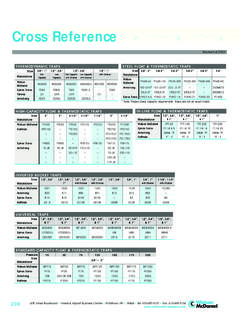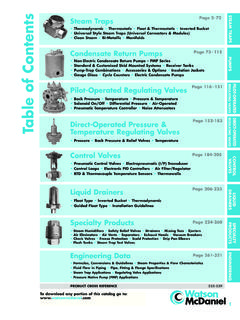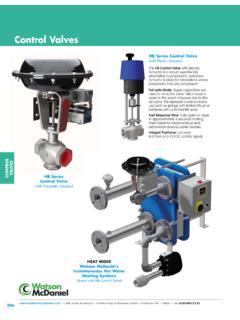Transcription of STEAM TRAP APPLICATIONS - Watson McDaniel
1 STEAM TRAP APPLICATIONS . INTRODUCTION TO STEAM TRAPS. WHAT IS A STEAM TRAP AND WHAT DOES IT DO? A STEAM trap is an automatic valve that allows condensate, air and other non-condensable gases to be discharged from the STEAM system while holding or trapping the STEAM in the system. Several different types of STEAM trap technologies exist to accomplish this extremely critical and necessary task. WHY ARE STEAM TRAPS REQUIRED? For any STEAM system to operate properly the condensate, air and other non-condensable gases such as carbon dioxide must be removed from the STEAM system. This is the purpose of the STEAM trap. CONDENSATE: When STEAM releases its heat energy, the STEAM reverts back to water. This occurs in a heat exchanger making hot water, in a radiator heating a room, or in a STEAM pipe transferring STEAM .
2 This water, technically referred to as condensate, must be removed from the system or the system would back up with water. The removal of condensate from the STEAM system is considered the primary function of the STEAM trap. AIR: Air exists in all STEAM pipes prior to system start-up when the system is cold. This air must be bled out of the piping system so that the STEAM can enter and eventually reach the designated process APPLICATIONS . If the air is not removed, the STEAM will effectively be blocked from entering the STEAM pipes by the residual air. In addition to blocking the STEAM , air acts as an insulator to heat transfer. Even after the system is filled with STEAM , small amounts of air can re-enter the system thru various paths such as boiler water make-up systems, vacuum breakers and air vents.
3 NON-CONDENSABLE GASES: Gases other than air such as carbon dioxide exist inside STEAM systems. These non-condensable gases must also be separated from the STEAM and removed from the system for all processes to operate properly. In addition to inhibiting STEAM flow and proper heat transfer, carbon dioxide can be very corrosive to components in the system. STEAM TRAP GENERAL APPLICATION CATEGORIES: DRIP APPLICATIONS : Drip APPLICATIONS are by far the most common application for STEAM traps. This application refers to removing the condensate that forms in STEAM lines when STEAM loses its heat energy due to radiation losses. Traps used in these APPLICATIONS are referred to as drip traps. Generally speaking, traps used for these APPLICATIONS require relatively small condensate capacities and don t normally need to discharge large amounts of air.
4 (Air removal is the primary function of air vents and process traps located throughout the system.) The most common trap choices for drip APPLICATIONS are thermodynamic for STEAM pressures over 30 PSIG, and float & thermostatic for pressures up to 30 PSIG. Inverted bucket traps are also commonly used for drip trap APPLICATIONS due to their ability to handle large amounts of dirt and scale often found in this type of application. PROCESS APPLICATIONS : Process trap APPLICATIONS refer to removing condensate and air directly from a specific heat transfer process such as a heat exchanger that could be making hot water or a radiator heating a room. Traps used in these APPLICATIONS are referred to as process traps. Generally speaking, traps used for process APPLICATIONS require larger condensate handling capability and also need to be able to discharge large amounts of air.
5 The most common trap choices for process APPLICATIONS are float & thermostatic traps and thermostatic traps. Both are known for their excellent condensate and air handling capabilities. In contrast, thermodynamic traps and inverted bucket traps, which have poor air handling ability, would normally make a poor choice for process APPLICATIONS . TRACING APPLICATIONS : STEAM tracing refers to using STEAM to indirectly elevate the temperature of a product using jacketed pipes or tubing filled with STEAM . A typical application would be wrapping a pipeline containing high viscosity oil with tracing tubing. The STEAM inside the tubing heats the oil to lower its viscosity, allowing it to flow easily thru the pipeline. Similar to any STEAM ENGINEERING. APPLICATIONS , a STEAM trap must be used on the end of the STEAM tubing to discharge unwanted condensate.
6 STEAM traps used in these APPLICATIONS are referred to as tracing traps. The most common trap choice for tracing APPLICATIONS is the thermostatic type. 428 Pottstown PA USA Tel: 610-495-5131. STEAM TRAP APPLICATIONS . INTRODUCTION TO STEAM TRAPS. The Thermodynamic Disc Trap is simple and compact and an excellent choice for a wide variety of drip APPLICATIONS . They excel in drip APPLICATIONS of pressures ranging from 30 psig to high pressure APPLICATIONS exceeding 3,000 psig, including superheated STEAM . The . TD600L is suitable for most drip APPLICATIONS , and offers reduced size discharge orifice holes which are preferable in terms of performance, longevity, and efficiency. The design of modern Thermostatic Bellows Traps allows these traps to be used on a wide variety of APPLICATIONS , from general service drips to small-to- medium process heating APPLICATIONS with relatively constant loads.
7 The welded stainless steel bellows is extremely rugged which prevents failure from waterhammer and corrosion, making these traps suitable for demanding industrial service. Also, because thermostatic traps subcool condensate, the condensate discharged generates less flash STEAM which may be advantageous in certain installations. For these reasons, Thermostatic Bellows Traps can be considered as a primary selection or as an alternative to other styles. The Float & Thermostatic Trap is the primary choice of STEAM trap for process APPLICATIONS . They are excellent at discharging air from the system during start-up and offer a wide range of capacities to accommodate the vast majority of process heating APPLICATIONS . Their design allows them to immediately respond to changing condensate loads and pressures, which is a typical requirement of continuous heating process APPLICATIONS ENGINEERING.
8 Where control valves are used to modulate STEAM flow. Available F&T models range from designs for low pressure heating to high-pressure and capacity industrial APPLICATIONS requiring cast steel or stainless steel. Tel: 610-495-5131 Pottstown PA USA 429. STEAM TRAP APPLICATIONS . DRIP LEG DESIGN. PURPOSE: Drip Legs are used for removing condensate from STEAM transmission and distribution lines. This helps ensure high quality STEAM for use in various plant APPLICATIONS and also will prevent damaging and dangerous waterhammer. OPERATION: As STEAM travels at high velocity through piping, condensate forms as the result of piping heat losses and/or improper boiler control resulting in condensate carryover. Drip legs are therefore located at points where condensate may accumulate to allow for drainage by gravity down to a STEAM trap for proper discharge from the system.
9 Since condensate drains by gravity, drip legs must be located on the bottom of piping and designed with diameters large enough to promote collection. INSTALLATION GUIDELINES: (see Figure 1). For drainage of STEAM transmission and distribution lines, drip legs should be located at bends in piping (direction changes), low points, end of line, and in straight run of piping every 200 feet. For protection of equipment such as regulators and control valves, drip legs should be installed directly ahead of the regulating or control valve line. Proper STEAM trap selection for drip APPLICATIONS is dependent upon application requirements, such as pressure, number of and distance between installed STEAM traps, ambient conditions, start-up requirements, etc. A commonly accepted practice is to use float & thermostatic (F&T) STEAM traps for low pressure STEAM systems up to 30 PSIG, and thermodynamic STEAM traps for STEAM pressures over 30 PSIG.
10 Because condensate drainage from STEAM systems is dependent upon gravity, drip leg diameter is critical for optimum removal larger is better. Collection leg diameter (DL) is recommended to be the same size as the STEAM main (D), up to 4 . For STEAM mains above 4 , the collection leg diameter may be half the diameter of the main, but not less than 4 . The length (L) of the drip leg for systems with automatic start-up should be a minimum of 28 to provide approximately 1 PSI head pressure. The length (L) of the drip leg for systems with supervised start-up should be x DL, but not less than 8 . Consider low-cracking pressure (1/4 PSI opening pressure) check valves after STEAM traps when discharging into condensate return lines. Check valves eliminate the possibility of condensate backing up through the STEAM trap into the system.








